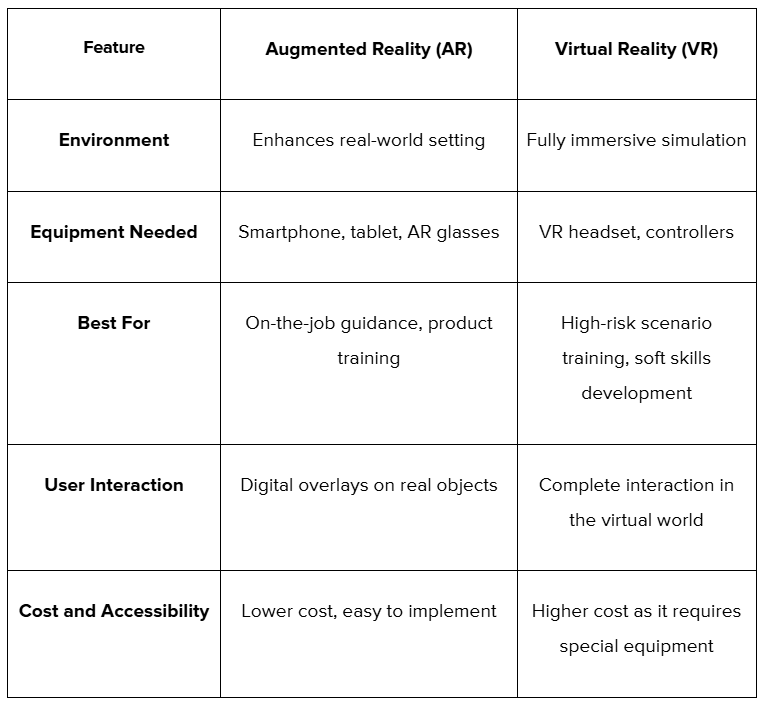
Sitting through long presentations and static training modules can make even the most motivated employees lose engagement. When training feels passive, key takeaways are often lost, and skills don’t easily transfer to everyday tasks.
But what if training felt more like real work? With immersive learning, employees step into hands-on scenarios, make critical decisions in a risk-free setting, and receive instant feedback. This interactive approach ensures they gain practical skills that stick, improving confidence and performance.
If you’re anticipating an impending shift, you’re wrong because the change is already happening. The global immersive technology market is projected to reach $169.88 billion by 2030, growing at a 27.9% CAGR as organizations embrace VR, AR, and AI-driven simulations to enhance learning experiences.
Immersive learning is not a passing trend; it is the future of corporate training. If you want to take your L&D program to the next level, this guide will explore how it works and why it’s more effective than the traditional method.
The Science Behind Learning Styles
Your workforce is made up of people, and no two of them are the same. Everyone learns differently. Regardless, traditional training programs often rely on static, one-size-fits-all content. This approach overlooks the fact that people absorb and retain information in distinct ways. How can learning ever be effective if this continues?
To understand it better, consider the VARK model, a widely recognized framework for learning styles, which categorizes learners into four main types:
- Visual Learners absorb information best through images, diagrams, and spatial representations. They benefit from charts, infographics, and video-based content.
- Auditory Learners prefer spoken explanations and discussions. Podcasts, narrated presentations, and interactive voice-guided modules work well for them.
- Reading/Writing Learners retain information best when they engage with text-based materials, such as reports, manuals, and written exercises.
- Kinesthetic Learners learn by doing. Hands-on training, simulations, and real-world practice help them grasp concepts more effectively.
Most corporate training programs focus heavily on visual and text-based content, unknowingly neglecting the needs of auditory and kinesthetic learners. This gap leads to disengagement and half-baked skill development, especially in roles that require hands-on experience.
Immersive learning solves all this by facilitating deeper engagement and better retention. But what exactly is it, and how does it transform training into a hands-on, interactive experience?
What Is Immersive Learning?
When you apply what you learn in real-world scenarios, you understand better. Consider a new manager who has completed a course on handling customer escalations. When faced with an actual upset customer, there’s a high chance that they will struggle.
That is not to say that the training wasn’t informative, but there’s only so much you can learn without hands-on practice. Immersive learning changes this by placing learners inside realistic, interactive environments where they can practice skills, make decisions, and receive immediate feedback.
Instead of passively consuming content, employees actively engage in simulated scenarios, improving retention and confidence before applying their knowledge on the job. It integrates elements of:
- Virtual Reality (VR) – Fully immersive digital environments that let learners practice without real-world risks.
- Augmented Reality (AR) – Digital overlays that enhance real-world training by providing additional information or interactive elements.
- Scenario-Based Learning – Realistic decision-making exercises that develop problem-solving skills.
- Gamification – Interactive challenges and rewards that increase motivation and engagement.
Early adopters are already seeing results. Studies show that VR-based training improves learning retention by up to 75% compared to traditional methods. With organizations investing heavily in AR, VR, and AI-powered simulations, immersive learning is quickly becoming a cornerstone of corporate training.
But how does immersive learning compare to experiential learning, and what makes the former a more scalable and adaptable solution?
Both immersive learning and experiential learning focus on hands-on experiences, but they are not the same. Experiential learning happens in real-world settings such as mentorship programs, workshops, or on-the-job training. Immersive learning simulates these experiences using technology, making training more scalable, flexible, and risk-free.
Here are some key differences between the two:
Augmented Reality (AR) vs. Virtual Reality (VR): Which One Works Best for Training?
Both AR and VR can enhance learning, but they serve different purposes in corporate training. AR overlays digital content onto the real world, while VR creates a fully immersive, simulated environment. Understanding their differences helps businesses choose the right tool for their training needs.
Key Differences Between AR and VR in Training
For corporate training, the following differences between AR and VR can be observed:
- Example of AR Training: A field technician uses AR glasses to receive real-time maintenance instructions while working on equipment.
- Example of VR Training: A manager practices conflict resolution in a simulated office environment, engaging with AI-driven virtual employees.
It is important to understand that immersive learning works for a reason that goes deeper than just technology. There is science involved in its effectiveness.
Why Does Immersive Learning Work?
Immersive learning is engaging and backed by cognitive science. Replicating real-world experiences strengthens memory retention, decision-making, and problem-solving skills in ways traditional learning can’t. This is why it makes a difference in learning:
1. Sensory Engagement Beyond Audio and Visual
Most traditional training relies on reading, watching, or listening, which limits engagement. Immersive learning activates multiple senses—sight, sound, and even touch—creating a deeper learning experience.
2. Spatial Simulation and Awareness
Training in realistic, 3D environments enhances spatial awareness and muscle memory, making skills easier to apply in real-world scenarios. This is especially useful in technical fields, healthcare, and high-stakes decision-making roles.
3. Stronger Memory Formation Through Experience
The brain retains information better when it’s connected to real actions and consequences. Immersive learning triggers the “testing effect”—where learners recall and apply knowledge in context, reinforcing long-term retention.
4. Reduced Distractions and Increased Focus
Unlike traditional eLearning, which competes with emails, notifications, and distractions, immersive environments fully engage learners, keeping them focused and improving comprehension.
Overall, immersive learning mirrors real-world experiences, leading to better retention, faster skill development, and stronger workplace performance. Beyond effectiveness, it also delivers measurable business benefits.
The Business Benefits of Immersive Learning
Beyond improving learning outcomes, immersive learning is revamping the way businesses train and develop talent. It’s not just about making training more engaging—it’s about delivering real, measurable results.
Companies investing in VR, AR, and simulation-based training are seeing higher knowledge retention, reduced training costs, and more confident, job-ready employees.
The impact goes beyond the classroom, driving performance and creating a future-ready workforce. Here is how you can benefit from immersive training:
1. Safer, Risk-Free Training for High-Stakes Scenarios
Employees can practice dangerous or complex tasks such as operating heavy machinery, handling hazardous materials, or responding to emergencies without real-world risks. This makes immersive learning ideal for healthcare, aviation, manufacturing, and crisis management.
2. Higher Engagement and Retention Rates
Interactive learning environments keep employees actively involved, reducing boredom and increasing motivation. Studies show that immersive learning can boost engagement by 60% compared to traditional methods.
3. Cost Savings Over Traditional Training Methods
While the initial investment in VR or AR technology may seem high, immersive learning reduces long-term costs by:
- Eliminating the need for travel and physical training setups
- Reducing reliance on live instructors
- Minimizing downtime from retraining or on-the-job mistakes
4. Real-Time Feedback and Performance Insights
AI-driven immersive platforms track learner progress, decision-making patterns, and skill mastery in real-time. Organizations gain data-driven insights to refine training programs and measure ROI.
5. Learning by Doing: Mistakes Without Consequences
Employees can make critical errors in a controlled setting, learning from failures without impacting operations or safety. This is especially valuable in fields requiring split-second decision-making.
6. Scalable and Accessible Training for a Global Workforce
Unlike traditional in-person training, immersive learning is fully scalable. Employees across different locations can train in consistent, high-quality learning environments—reducing skill gaps and ensuring standardization.
Immersive learning is reshaping corporate training strategies because it enhances engagement, retention, and efficiency. However, as adoption grows, organizations must navigate key challenges and considerations to maximize its impact.
Overcoming the Challenges of Immersive Learning: Making Adoption Seamless
While Immersive learning is transforming corporate training, like any innovation, it comes with hurdles. You might be concerned about costs, technology integration, and adoption, but with the right strategy, these challenges can be minimized.
In fact, Organizations that address these barriers early will gain a competitive advantage, ensuring a smooth transition to VR, AR, and AI-powered training.
1. High Initial Investment in Technology
VR headsets, AR devices, and software development can be costly. However, businesses can:
- Start with AR-based mobile training, which requires only smartphones or tablets.
- Use off-the-shelf VR training modules before investing in custom-built content.
- Explore subscription-based immersive learning platforms to reduce upfront costs.
2. Hardware and Software Compatibility Issues
Not all employees have access to high-end VR equipment. To improve accessibility:
- Offer cloud-based VR solutions that work across devices.
- Use lightweight AR applications that function on mobile phones.
- Ensure platforms integrate with existing Learning Management Systems (LMS).
3. Resistance to New Learning Methods
Employees and trainers may be hesitant to shift from traditional learning methods. To drive adoption:
- Provide introductory VR/AR training to familiarize teams.
- Use hybrid learning models, combining immersive experiences with instructor-led sessions.
- Demonstrate measurable benefits, such as higher engagement and retention rates.
4. Content Development Challenges
Creating high-quality, interactive training content requires expertise. Organizations can:
- Leverage pre-built immersive training modules from industry providers.
- Partner with immersive learning specialists to design customized solutions.
- Use AI-powered content creation tools to streamline development.
5. Measuring ROI and Training Effectiveness
Unlike traditional training, where progress is tracked through quizzes and assessments, immersive learning requires different metrics. Companies can:
- Track engagement levels, decision-making patterns, and skill application in real-time.
- Use AI-driven analytics to assess learner performance and training effectiveness.
- Compare immersive training outcomes with traditional training methods to evaluate ROI.
The way companies train their teams is changing fast, and if you’re not thinking about immersive learning yet, you soon will be. VR, AR, and AI-driven simulations aren’t just making training more engaging; they’re delivering real results. And here’s the best part: It’s not just for big corporations with endless budgets. Businesses of all sizes are finding ways to integrate immersive learning and stay ahead.
However, the best of this learning method is still yet to come as its future looks even more promising.
The Future of Immersive Learning: Where Training Is Headed Next
If you’re leading an L&D team, you already know that traditional training methods aren’t keeping up with the speed of change. Employees need to build skills faster, more effectively, and with real-world confidence—and that’s exactly where immersive learning is headed.
With AI, the metaverse, and real-time data analytics, the next generation of immersive learning will be even more personalized, adaptive, and scalable.
1. AI-Driven Personalization
AI will tailor learning experiences based on individual performance, adjusting difficulty levels and recommending targeted content in real-time. This means no two learners will have the same training path—everything will be customized to their strengths and gaps.
2. The Rise of the Corporate Metaverse
Companies are already experimenting with virtual training campuses, where employees can collaborate, learn, and practice skills in fully interactive environments. Expect more lifelike avatars, AI-powered roleplay scenarios, and persistent training worlds that feel just like the real workplace.
3. 5G-Powered Mobile Immersive Learning
Faster connectivity means seamless, high-quality VR and AR training on the go. Employees won’t need high-end headsets—lightweight, mobile-based immersive learning will become the norm, making training more accessible than ever.
4. Deeper Data Insights for L&D Teams
AI-powered analytics will track every decision learners make in immersive environments, providing L&D teams with real-time insights into skills, behaviors, and improvement areas. This data will make training more targeted, measurable, and impactful.
5. Increased Adoption Across Industries
Right now, immersive learning is big in healthcare, aviation, and manufacturing, but that’s changing. Soft skills training, leadership development, and customer service simulations are becoming key areas for VR and AR, making immersive learning a must-have across industries.
The bottom line? Immersive learning is here to stay. As technology advances, training will become more realistic, personalized, and effective, helping companies future-proof their workforce like never before. Are you considering being an early adopter and leading from the front? Here’s how you can do so effectively.
How to Successfully Implement Immersive Learning in Your Organization
Adopting immersive learning goes beyond investing in VR headsets or developing AR apps—it’s about creating a seamless, engaging, and results-driven training strategy. Follow this step-by-step guide to get started:
1. Define Clear Training Goals
- Identify specific skills or challenges immersive learning can address.
- Align training objectives with business outcomes (e.g., reducing errors, improving soft skills, enhancing compliance training).
2. Choose the Right Technology for Your Needs
- VR for high-risk, hands-on training (e.g., crisis management, equipment handling).
- AR for on-the-job support and knowledge retention (e.g., remote assistance, guided work instructions).
- AI-driven simulations for soft skills training (e.g., leadership, customer service).
3. Start Small with Pilot Programs
- Test immersive learning with a single department or use case.
- Gather feedback from employees and refine the experience before scaling.
4. Ensure Accessibility and Scalability
- Invest in mobile-friendly AR tools for easier adoption.
- Choose platforms that integrate with your LMS and existing training programs.
5. Measure Impact and Continuously Improve
- Track engagement, knowledge retention, and skill application using AI-powered analytics.
- Compare immersive training outcomes with traditional methods to justify ROI.
Immersive learning isn’t just about making training more engaging—it’s about making it more effective. When done right, it reduces training time, improves knowledge retention, and builds real-world confidence in ways traditional methods simply can’t.
Conclusion
Immersive learning is changing the game for corporate training. No more passive learning, no more forgettable courses—just real-world practice in risk-free, interactive environments. With VR, AR, and AI-driven simulations, employees can learn by doing, build confidence, and retain knowledge faster than ever before.
How EI Helps You Make the Shift
At EI, we go beyond adding technology to your training—we design engaging, results-driven, immersive learning experiences that truly transform how your teams learn.
- Custom-built VR and AR learning tailored to your industry and business needs.
- Interactive simulations, story-based learning, and gamification to boost engagement
- AI-powered analytics and adaptive learning paths for smarter, more effective training
Whether you’re looking to enhance compliance training, improve soft skills, or prepare employees for high-risk tasks, our immersive solutions create meaningful learning experiences that drive real performance improvements. Learn more about our immersive learning solutions.
If you’re ready to take your training to the next level, now’s the time to act. Immersive learning isn’t the future—it’s happening right now, and companies that embrace it are gaining a clear competitive edge.
Let’s create a high-impact, immersive learning strategy that works for your business. Contact us today.





